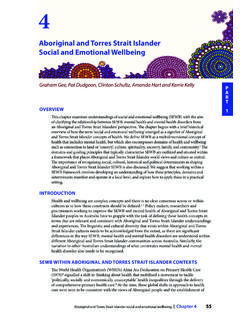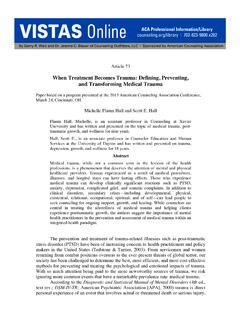Transcription of Mental Health Support Teams for Children and Young …
1 Mental Health Support Teams for Children and Young People in Education A Manual 2 Mental Health Support Teams for Children and Young People in Education A Manual 3 Contents Foreword 6 Dear Mental Health Support team a letter from a Young person 7 Glossary 9 Mental Health Support team (MHST) Operating Principles 13 Purpose of this document 15 1. Introduction and background 16 What is a Mental Health Support team (MHST)? 16 Background and context 17 Core functions of Mental Health Support Teams (MHSTs) 17 2.
2 Working with education to improve Mental Health 19 Understanding the school and college landscape 19 The role of schools and colleges 21 What is a whole school/college approach? 22 Figure 3. DfE: school/college roles in Mental Health and wellbeing 24 Leadership and Management 24 Identifying need and monitoring impact 25 Staff development 26 Enabling Student Voice Children and Young people involvement in design and approach 27 Working with parents and carers 27 The Role of Local Authorities and Regional School Commissioners 28 Regional schools commissioners: 29 The role of Ofsted 30 3 Delivering the core functions 31 Deliver evidence-based interventions for Children and Young people with mild-to-moderate Mental Health problems 31 Identifying and understanding the needs of Children , Young people, and their families and carers 33 Further assessment by Mental Health Support Teams (MHSTs)
3 34 Formulation 35 Components of a good assessment 36 Care plans 36 Supporting the senior Mental Health lead in each education setting to introduce, develop and Support in the delivery of their whole school/college approach 37 Giving timely advice to school and college staff, and liaising with external specialist services, to help Children and Young people to get the right Support and stay in education 38 4 Monitoring Outcomes and Impact 40 Data collection 40 Routine collection of outcomes of evidence based interventions 41 5 Workforce 43 4 Workforce model 43 Education Mental Health Practitioners (EMHPs) 43 Senior Mental Health Clinicians Error!
4 Bookmark not defined. Delivery 43 Error! Bookmark not defined. Plans 44 MHST staff wellbeing 45 Mental Health roles in education settings 45 School/ college MHST coordinator 45 Senior Mental Health lead 45 Training 47 Mental Health Support Teams (MHSTs) 47 Training for education professionals 47 Training for pupils, students, parents and carers 47 Competences 48 Supervision 48 6 Governance, Accountability and Senior Leadership of the Mental Health Support Teams (MHSTs) 50 Governance and Oversight 50 Case Study Examples Governance Structures: 51 Please note this is place marker for additional content providing case study 51 examples of good governance structures.
5 51 Operational Governance 51 7 Developing and implementing the Mental Health Support Teams (MHSTs) 52 Co-production 52 How to ensure genuine co-production 53 Understanding the needs of the local population and education setting 53 Accessing Mental Health Support Teams (MHSTs) 54 Location of Mental Health Support Teamss 55 Information sharing, confidentiality and consent 55 Safeguarding 56 Utilising digital resources 56 Support for transitions 57 8 Addressing disadvantage, inequalities and need 58 Advancing Mental Health equality, and narrowing Health inequalities and disadvantage 58 Strategies to proactively advance Mental Health equality 59 9 Learning from the Trailblazers 60 10 Abbreviations 61 11 How was this document developed?
6 62 Expert Reference Group members 62 5 Young people and carer reference group 62 NCCMH technical team and national advisers 63 Special advisers 63 Wider stakeholder group 63 12 References 63 6 Foreword I have been delighted to chair the Expert Reference Group charged with producing this manual. I would like to thank everyone who has given their time and enthusiasm to the project, with particular reference to the experts by experience whose pragmatic and honest approach always makes such a difference. Special thanks also to the technical team at the National Collaborating Centre for Mental Health (NCCMH) whose tireless attempts to capture the rich and diverse conversations are truly impressive.
7 The manual is a small, but important, part of a much bigger programme. It tries to look at the heart of some of the challenges that multi-agency programmes face and build principles and frameworks for success. The worlds of Health and education are really very different the very separate training to date of professionals in these fields has led to differing approaches to intervention, differing cultures and often separation by a common language. So, conversations about things like the framing of interventions for Children , and the defining of mild and moderate Mental Health issues are challenging but important.
8 It is also easy for professionals to go into their own comfort zones; for Health professionals, this is often the concentration on individual clinical interventions; for education, it is often a default to a whole-school/college approach or problem solving for individual Children and Young people. And yet for success, to really make a difference to outcomes for Children and Young people, all of the elements need to come together, and this has been the task of the manual: to understand how to speak to both teachers and clinical staff in ways that make sense to them and enable them to see this area of work as a priority and a key part of how we Support Children and Young people.
9 We have been really well supported in this by some excellent practitioners and I would want to pay particular tribute to the work going on in Liverpool and Barnsley. The fact they have taken on these challenges and can now demonstrate the real difference this makes to Children and Young people gave us the real impetus to continue. This manual is being produced at the very early stages of the work of the trailblazers which are not yet fully operational, and in future versions we will want to incorporate the learning from this key practice as it develops. The really important thing about the manual is its underlying belief that Children s Mental Health and wellbeing matters.
10 Working in partnership with education at an early stage can make a real difference to Young people s outcomes and we can move Mental Health , for many Children and Young people, from clinics into education settings and communities, destigmatise it and promote positive Mental Health . Dame Christine Lenehan Chair of the Expert Reference Group Director, Council for Disabled Children 7 Dear Mental Health Support team a letter from a Young person I am currently both scared and confused; my mind is consumed with overwhelming feelings and emotions, making even the smallest tasks so incredibly difficult.








